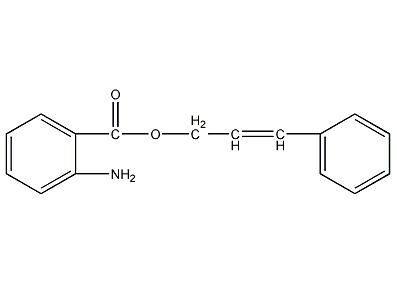
Structural formula
| Business number | 01XT |
|---|---|
| Molecular formula | C16H15NO2 |
| Molecular weight | 253.30 |
| label |
Cinnamon-2-aminobenzoic acid, Cinnamon -2 – amino acid, artificial flavors |
Numbering system
CAS number:87-29-6
MDL number:MFCD00053631
EINECS number:201-738-8
RTECS number:CB2725000
BRN number:2733435
PubChem ID:None
Physical property data
1. Physical property data
1. Properties: Brown powder with balsamic and fruity aroma.
2. Density (g/mL, 25/4℃): 1.18
3. Relative vapor density (g/mL, air=1): Uncertain
4. Melting point (ºC): 64-66
5. Boiling point (ºC, normal pressure): 322
6. Boiling point (ºC, 5.2kPa): Uncertain
7. Refractive index: Uncertain
8. Flash point (ºC): 322
9. Specific rotation (º): Uncertain
p>
10. Autoignition point or ignition temperature (ºC): Uncertain
11. Vapor pressure (kPa, 25ºC): Uncertain
12. Saturated vapor pressure (kPa, 60ºC): Uncertain
13. Heat of combustion (KJ/mol): Uncertain
14. Critical temperature (ºC): Uncertain
15. Critical pressure (KPa): Uncertain
16. Log value of oil-water (octanol/water) partition coefficient: Uncertain
17. Explosion upper limit (%, V /V): Uncertain
18. Lower explosion limit (%, V/V): Uncertain
19. Solubility: Uncertain
Toxicological data
- Toxicity classification Poisoning
- Acute toxicity: Oral – rat LD50: 5000 mg/kg; Dermal – rabbit LD50: 5000 mg/kg.
- Under closed conditions, the product will have a slight irritating effect after being applied to intact or damaged rabbit skin for 1 day. If Vaseline with a concentration of 4% of the product is applied to human skin and a closed contact test is conducted for 48 hours, no irritation is found. Maximum sensitization tests were conducted in humans at the same doses. No abnormalities were found.
Ecological data
None yet
Molecular structure data
5. Molecular property data:
1. Molar refractive index: 77.72
2. Molar volume (cm3/mol): 214.9
3. Isotonic specific volume (90.2K): 576.2
4. Surface tension (dyne/cm): 51.6
5. Polarizability (10-24cm3): 30.81
Compute chemical data
1. Hydrophobic parameter calculation reference value (XlogP): 4
2.Number of hydrogen bond donors: 1
3. Number of hydrogen bond acceptors: 3
4. Number of rotatable chemical bonds: 4
5. Mututation Number of structures: 2
6. Topological molecular polar surface area (TPSA): 52.3
7. Number of heavy atoms: 19
8. Surface charge: 0
9. Complexity: 308
10. Number of isotope atoms: 0
11. Determine the number of atomic stereocenters: 0
12. The number of uncertain atomic stereocenters: 0
13. The number of determined chemical bond stereocenters: 1
14. The number of uncertain chemical bond stereocenters: 0
p>
15. Number of covalent bond units: 1
Properties and stability
Brown powder with balsamic and fruity aroma.
Storage method
Store in a cool, dry place.
Synthesis method
Dehydration and esterification of anthranilic acid and cinnamic alcohol.
Purpose
This compound has been used to flavor food and daily chemicals more than 60 years ago. In 1974, the European Council confirmed that this compound is an artificial flavor that is harmless to public health.

 微信扫一扫打赏
微信扫一扫打赏

